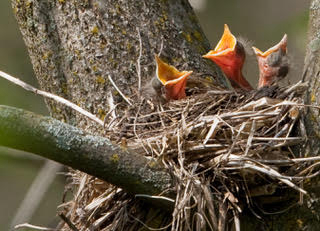
Robin nests are common sites during the spring in Ohio. Observe nesting and young animals from a distance and avoid intervening without guidance from a wildlife professional.
|
COLUMBUS, Ohio – Well before the official start of spring, young wildlife will make appearances in backyards, local parks, and unexpected areas. The Ohio Department of Natural Resources (ODNR) Division of Wildlife encourages Ohioans to keep wildlife wild by observing them from a distance and reducing interactions with young animals.
Wildlife parents are devoted to their young and rarely abandon them. A young animal’s best chance of survival is with its mother. Usually, young wildlife observed alone are not orphaned or abandoned, but are waiting for a parent to return. Watch these young animals from a distance and avoid intervening without guidance from a wildlife professional. Most wildlife taken in by people other than trained and licensed wildlife rehabilitators do not survive despite the good intentions of their rescuers.
Many wildlife species are raised by one parent and are left alone several times during the day while the parent ventures off to find food. In the case of deer, a doe hides her young from predators by leaving them alone in a secluded spot such as a grassy meadow or a flower bed. A hidden fawn has virtually no scent, and when left alone it is difficult for predators to find. The doe is usually nearby and will tend to the fawn during the night. It is common to find fawns hidden in backyards. If you do find a fawn in your yard, keep pets away, minimize disturbances to the area, and wait for the mother to return.
Baby birds that have fallen from their nests are one of the creatures most likely to be encountered. Many times, these young birds do not need to be removed from the wild to survive. Contrary to popular belief, human scent will not prevent parents from returning to care for their young. Return a baby bird to its nest and walk away so the parents can feed it without fear of humans. If a natural nest can’t be located, parents will often care for baby birds placed nearby in a makeshift nest. Young birds with feathers that are observed flapping on the ground likely left the nest on their own and are learning to fly. Keep pets away and give these fledglings the space to learn to fly on their own.
It is usually a treat to observe a young animal, but that privilege becomes a responsibility if the animal has been orphaned, abandoned, or injured. If you see open wounds or other injuries, or you know for a fact that a young wild animal has lost its parent, research solutions before taking action. Specific guidance on how to best help commonly encountered wildlife species is available on the Orphaned and Injured Wildlife page at wildohio.gov.
To help protect young and vulnerable wild animals, keep pets under control so they do not raid nests or cause injuries. Remember to keep pets inoculated against parasites and diseases. Always check for nests before cutting down trees or clearing brush. It is best to cut trees and clear brush in the autumn after the nesting season is finished. Teach children to respect wildlife and their habitat by observing from a distance.
State and federal laws protect and regulate wildlife in Ohio, and only trained and licensed wildlife rehabilitators, with permits issued by the Division of Wildlife, may possess and care for native wildlife. These laws are in place for the benefit of humans as well as wild animals.
Contact a local wildlife official before acting. Call 800-WILDLIFE (945-3543) or visit wildohio.gov to find a licensed wildlife rehabilitator in your area and to learn more about species-specific guidance. Human intervention is always a wild animal’s last hope for survival, never its best hope.
Good intentions can hurt. Keep wildlife in the wild.
The mission of the Division of Wildlife is to conserve and improve fish and wildlife resources and their habitats for sustainable use and appreciation by all. Visit wildohio.gov to find out more.
ODNR ensures a balance between wise use and protection of our natural resources for the benefit of all. Visit the ODNR website at ohiodnr.gov.